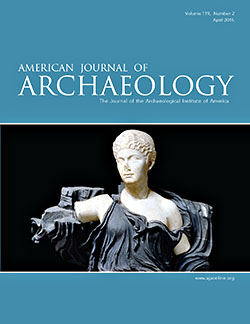AJA Open Access
BY-NCApril 2015 (119.2)
Book Review
Rome Beyond Its Frontiers: Imports, Attitudes and Practices
Edited by Peter Wells
Reviewed by Greg Woolf
Objects manufactured within the Roman provinces often appear in archaeological contexts from beyond the frontiers of the empire. Some local productions from the same areas make use of technologies developed within the empire and/or seem to refer stylistically to objects made in the Roman provinces. As Wells notes in his introduction to this volume of papers, which derives from a panel at the 2010 Roman Archaeology Conference in Oxford, these linked phenomena have long been known and documented. Many papers take their orientation from Der römische Import im freien Germanien (H.J. Eggers [Hamburg 1951]). The quality of that documentation has improved enormously thanks to the work of Kunow, Hedeager, Lund Hansen, and many others, but the significance of these phenomena remains unclear. The focus of this panel was understanding the use, meaning, value, and function of these objects within local societies (rather than, e.g., on what they might tell us about economic relations or on the use of provincial manufactures in dating prehistoric sites). Surprisingly, Wheeler’s exciting Rome Beyond the Imperial Frontiers (London 1954) is nowhere mentioned.
The present volume comprises seven short papers, the whole topped and tailed by Wells. Hunter contributes a paper on Roman objects in Scotland; Grane an account of Roman goods in Scandinavia; Wells himself a study of Roman goods in graves along the Rhine and Upper Danube and their relation to social and political change. Schmidt gives an account of Roman imports at the settlement site of Frienstedt (Thuringia); Soderberg reviews the material from Ireland, Tomber that from India; and Wicker looks at the origin of Scandinavian bracteates. The period considered is very broadly the first four centuries C.E. Wells rightly points out (9–11) the prehistoric background to these phenomena, and a few papers—Wicker’s and Schmidt’s in particular—look forward to the Migration period. The contributors were evidently allowed considerable latitude in their choice of approach: almost all have worked through discussion of a small number of case studies, some lavishly illustrated. No overall synthesis emerges, but an excellent idea of the range of material and contexts involved is given by the entire collection. The objects concerned include terra sigillata; other ceramic vessels; amphoras, silver and gold drinking vessels, and plate; weaponry; bronze and iron cauldron and buckets, glass vessels; silver coins; jewelry; building stone and tiles. The contexts include graves and hoards (of various kinds) and also domestic sites. There are marked regional variations in the kinds of goods concerned and in the contexts from which they have been recovered. Quantification is difficult, but there are some surprises. For example, Thuringia has much more, and Ireland much less, material than might be expected given their relative proximity to the frontiers.
Aside from this, perhaps the chief interest of this volume is in its extreme methodological fragmentation. There is no consensus on whether to designate these objects as luxuries or exotics or imports or prestige goods, nor whether we should imagine them moving through trade, diplomatic gifts, or as plunder or simply goods brought back by returning auxiliaries. There are occasional strong disagreements over interpretation. So Grane’s chapter can be read largely as a critical response to the use of postcolonial and social theory in Ekengren’s Ritualization, Hybridization, Fragmentation: The Mutability of Roman Vessels in Germania Magna AD 1–400 (Lund 2009) (available online at www.lunduniversity.lu.se/lup/publication/1369995) and a defense of “empirical” approaches and greater use of classical sources. (Wicker is much more positive about Ekengren’s approach.) Hunter pursues the life cycles of these objects, reflecting on their changing social roles and uses in specific contexts of provincial and Iron Age societies—feasting and bodily ornament, for instance—and exploring the range of processes concealed by terms such as “emulation” and “deposition.” Soderberg employs entanglement theory and makes use of the ideas of Jane Webster and Martin Pitts. Wells himself suggests we might think of the larger phenomena in terms of globalization (7), through network theory (123) or as a product of exchange systems such as the Kula ring or the Hopewell Interaction Sphere (124–25). His own chapter links changes in the use of imports to the emergence of complex polities north of the Roman frontier, making use of both cognitive psychology and ethnographic analogy.
What conclusions may we draw from listening in on this debate? The immediate and obvious points are that (1) not all these objects are alike, and (2) understanding each category depends on careful contextualizations. This is probably common ground. But can we say more than that the material culture of the provinces was a turbulent mix that often spilled over into neighboring areas, where it was put to all sorts of odd and un-Roman uses? Perhaps, but we may need to look at different material first. Fulford once suggested, in a similar conference published as Barbarians and Romans in North-West Europe (Oxford 1989) that we spend more time looking at the uses, meaning, and contexts of similar material within the empire. How do the finds from Frienstedt compare with those from similar sites in the Danube provinces? How different were “hoards” outside and inside the empire? Garrow and Gosden’s Technologies of Enchantment (Oxford 2012) has now shown that much “Celtic” art in Britain was produced, used, and ritually deposited during the period of Roman rule. Hunter makes the point that in his study area, deciding which sites are “within” and which “beyond” the frontier is not easy. Thinking away the frontier for a while might help us decide whether we are indeed dealing with alien appropriations of “Roman” material, or just observing—in places where they are exceptionally visible—the fringes of a much wider set of cultural practices.
Greg Woolf
Institute of Classical Studies
School of Advanced Study, London
greg.woolf@sas.ac.uk
